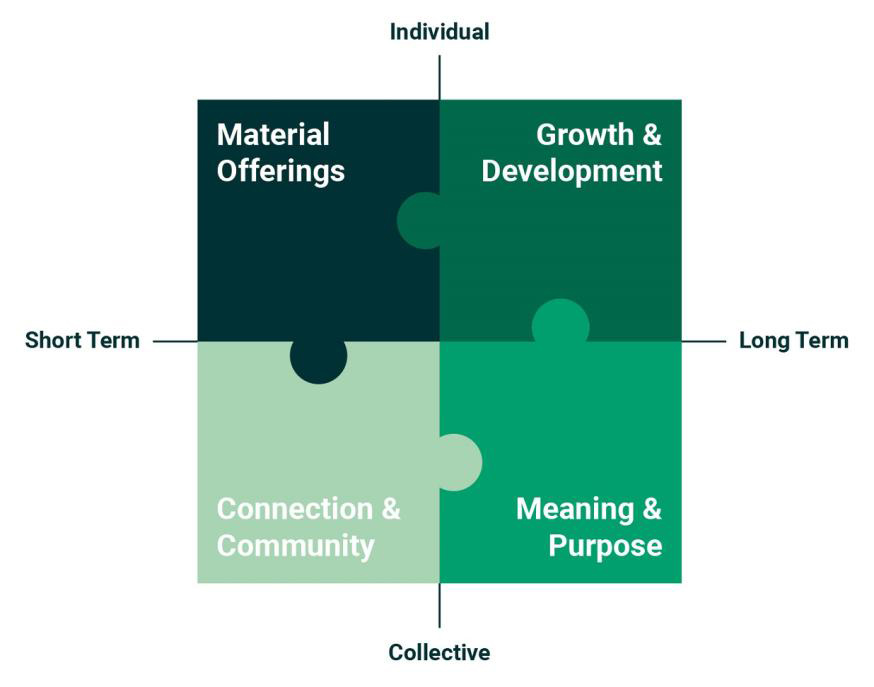Many companies tend to zone in on material offerings when trying to meet employees’ needs. Besides compensation, this includes aspects such as the physical office space, equipment, commuting subsidies, flexibility, and other perks. These are generally the easiest levers to pull, are the most straightforward to measure and negotiate, and are immediately appreciated. For example, it doesn’t take much to give a bonus, make the call to allow employees to work from home, or stock the office pantry with free snacks.
Prior to the pandemic, the most important topic among management thinkers was meaning and purpose. These are the organization’s aspirational reasons for existing and are the answer to the central question of why employees do the work that they do.
Employee needs are dynamic and should be reassessed on a regular basis. As Covid-19 showed, the world isn’t going to stand still, and organizations must be prepared to adjust accordingly. Ongoing measurement is critical to evaluating how relationships among various elements within the system may shift as tensions or reinforcing loops strengthen over time.
It may also not be the most effective tactic. For instance, given that flexibility is top-of-mind for many workers, employers who adopt this strategy could be tempted to offer employees hybrid or remote working arrangements and leave it at that. However, we found that most people we spoke to who worked remotely felt less connected to their companies than when they went to the office. Organizations may end up trying to buy loyalty by giving employees something that, in fact, reduces loyalty. This doesn’t work, and it’s certainly not sustainable.
This could necessitate the restructuring of internal processes because many organizations currently manage the four components separately: HR oversees growth and development, while the C-suite owns meaning and purpose. Companies also tend to tackle the factors sequentially rather than together, which overlooks how changes in one factor affect others.
To aid in this process, we developed an online instrument that allows individuals and organizations to measure, visualize, and analyze their iEVP. The tool maps individual needs against what people feel they get from their organizations. Armed with these data, both individuals and organizations can better understand where they stand and where gaps—and thus opportunities—exist.
Communication and flexibility are key
As this one example illustrates, these factors are inextricably interconnected. Although the iEVP is no silver bullet, it can help organizations frame, address, and meet employee needs in a balanced and comprehensive way that ultimately benefits all parties involved.
Beyond material offerings
Paying attention to this aspect of the iEVP can help align employees’ personal values and objectives with those of the company. Several studies support its importance to employee retention. For instance, research shows that some individuals will accept lower salaries for doing meaningful work, something we’ve also witnessed in our analysis of different organizations.
Our PROMISE: Quality Digest only displays static ads that never overlay or cover up content. They never get in your way. They are there for you to read, or not.
The iEVP provides a common language to help employers and employees come to the table and facilitate a conversation. However, to implement this effectively requires commitment, time, and effort to ensure that the four factors are being addressed holistically.
Against this complex backdrop, there’s a pressing need to agree on the ground rules of the new workplace and foster a culture and environment that promote employee retention and engagement, as well as organizational performance.
A holistic approach
Quality Digest does not charge readers for its content. We believe that industry news is important for you to do your job, and Quality Digest supports businesses of all types.
But problems could arise if meaning and purpose are addressed in isolation. For instance, UNICEF’s mission to protect the world’s children is arguably one of the most compelling and motivating purposes out there, and has long been a primary asset for attracting and keeping talent.
Published: Wednesday, July 19, 2023 – 12:01
